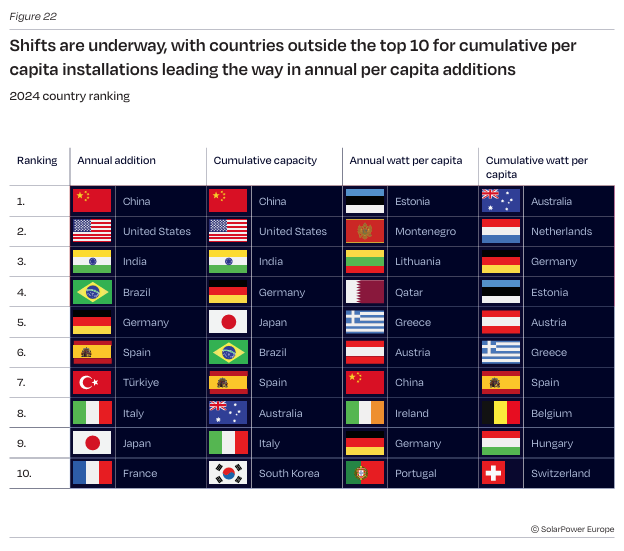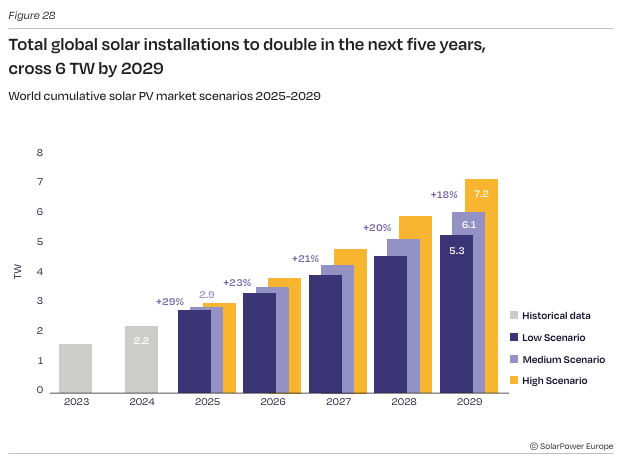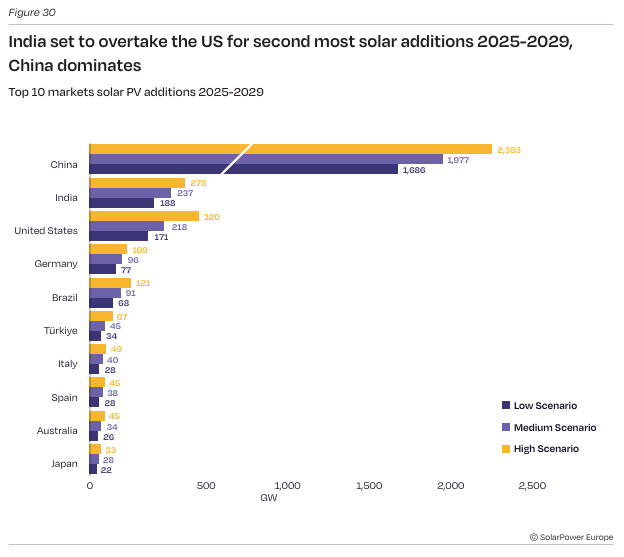Solar energy continues to break records—solar panel installations reached a record 597 GW in 2024, marking a 33% increase compared to the previous year. The total installed solar capacity worldwide surpassed 2 terawatts in 2024. It took nearly 70 years to reach the first terawatt, but only two years to double that number. These impressive results for the solar industry come from a new report by SolarPower Europe, the leading European solar energy association, of which the Association RES Serbia is a member.
The Global Market Outlook For Solar Power 2025-2029 report, which provides a comprehensive insight into the dynamics and trends of the solar sector, shows that the Asia-Pacific region remains the main driver of solar expansion, thanks to China, which accounts for 70% of all newly installed capacity worldwide. However, achieving the global goal of 8 TW by 2030 will require accelerated development and the installation of 1 TW of solar capacity per year, SolarPower Europe warns.
Solar power generation in the EU surpassed coal for the first time in 2024
The rapid growth of solar systems has cemented the role of solar as a key source of global electricity generation. In 2024, solar accounted for 81% of all new renewable energy capacity, nearly doubling its share of the global energy mix over the past three years. This transformation is primarily driven by technological advances, falling prices of solar components, and the priorities of countries that have focused their efforts on climate resilience and energy security.
– Although solar PV still represents a relatively small share of global electricity generation, its pace is speeding up across regions, breaking records in both emerging markets and advanced economies. Brazil, for example, has significantly increased its solar generation in recent years and is now the fifth-largest solar producer. In 2024, solar power generation in the European Union surpassed coal for the first time, with its share in the electricity mix exceeding 10% and reaching 20% or more in markets such as Cyprus, Greece, Hungary and Spain – SolarPower Europe pointed out.

China is the first country in terms of new solar capacity, followed by the United States and India
In 2024, there will be significant changes in the global solar market. China has installed 329 GW of new solar, more than double the capacity of all other countries in the top 10 combined. It is followed by the United States (50 GW) and India (30.7 GW).

What once seemed ambitious is now within reach. SolarPower Europe states that solar is on track to exceed 7.1 TW of total capacity by 2030, with annual installations could reach 1 TW. Although growth is expected to slow to 10% in 2025, which would bring 655 GW of new installations, the long-term growth trend remains. From 2027 onwards, double-digit growth is expected to continue, bringing the global market to 930 GW of annual installations by 2029..
China continues to lead with 985 GW of total installed capacity, accounting for 44% of global capacity. The U.S. retained second place with 223 GW, although its share fell again by 1 percentage point to 10 percent. India and Germany have made significant progress, surpassing the 100 GW threshold in 2024. This growth confirms their growing influence in the global energy sector.

Total solar capacity in 2025 will reach 2.9 TW
After reaching 2 TW of total installed solar power capacity in 2024, global solar PV capacity will increase significantly, with total capacity projected to reach 2.9 TW in 2025. In the medium scenario envisaged by SolarPower Europe, total capacity is expected to grow further to 3.6 TW in 2026, 4.3 TW in 2027, 5.2 TW in 2028 and 6.1 TW by 2029. These figures remain largely in line with last year’s Global Market Outlook projections.

Projections show that the global installation of solar energy will change significantly in the next five years. China will maintain its dominant position, with an expected 2 TW of new capacity in 2025-2029, while India takes second place, surpassing the United States (218 GW) with a projected 237 GW of new installed capacity.
Germany and Brazil will install over 90 GW in the coming period, while Turkey is making great progress, consolidating its position in the top ten with an expected 45 GW. Italy recorded moderate growth of 5 GW, as did Spain, Australia and Japan.

Annual growth of 1 TW is likely to be achieved in 2030
– When comparing our expectations with the most recent 2030 projections from other major solar analysts, we remain more optimistic than everyone else. Our Medium Scenario sees 7.1 TW of global solar capacity by 2030 – slightly higher than BloombergNEF’s forecast (7.0 TW). We also exceed projections from S&P Global (5.8 TW), the updated IEA forecast (6.7 TW), and IRENA’s WETO 2024, which lags behind most at just 5.5 TW – was said by SolarPower Europe.
To achieve the 2030 goal set at COP28, the Global Solar Council outlines eight key recommendations, including improving grid flexibility, closing investment gaps, promoting storage and streamlining permits. It also emphasizes the need for resilient supply chains, ESG standards, the development of a skilled workforce, as well as stable policies. Coordinated global action is essential to realize solar potential and ensure a fair, sustainable energy future.
You can read the full report below:


